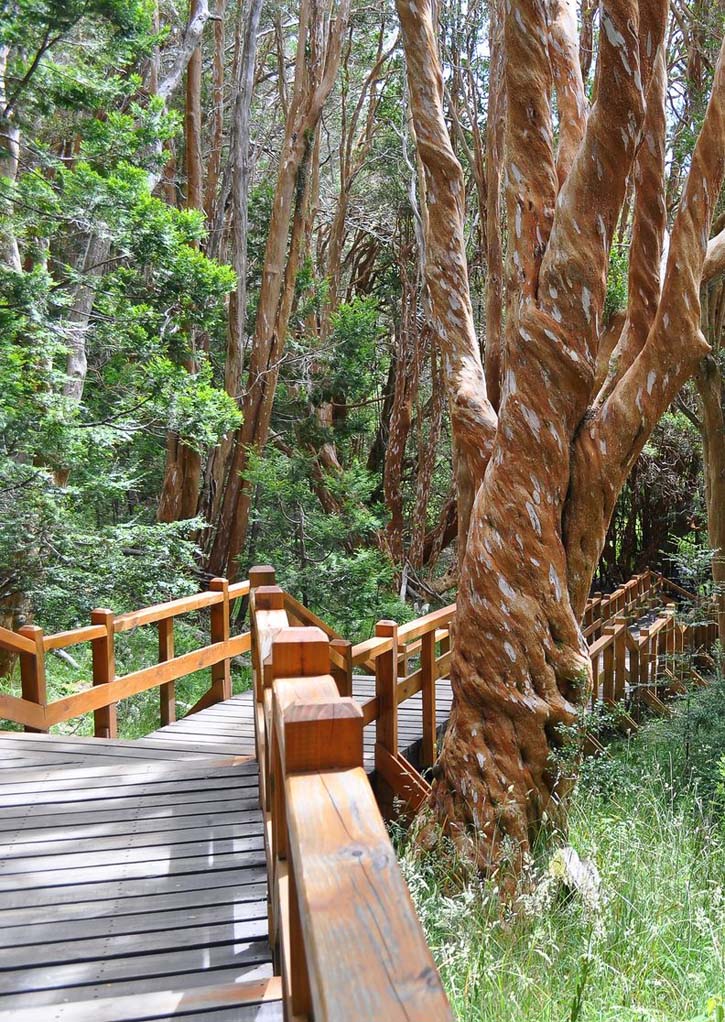Argentina’s Parque Nacional Los Arrayanes is best reached through nearby La Villa, a lakeside town neighboring Villa La Angostura. Los Arrayanes is larger than the town of La Villa, but they’re so close that it feels more like a sprawling city park.
Local folklore says Walt Disney’s cartoon feature Bambi modeled its forest after the arrayán woodland at the tip of Península Quetrihué…Local folklore says Walt Disney’s cartoon feature Bambi modeled its forest after the arrayán woodland at the tip of Península Quetrihué, a former ranch that became the national park in 1971. With their bright white flowers, the eye-catching red-barked forests of Luma apiculata do bear a resemblance, but a Disney archivist has pointed out that Bambi was in production before Walt’s 1941 trip to Argentina, and that he never visited the area.The park occupies Quetrihué’s entire 1,753 hectares, which stretch south into Lago Nahuel Huapi. Its namesake forest covers only about 20 hectares, but the rest of the peninsula bristles with trees like the maitén and the southern beeches coihue and ñire, as well as colorful shrubs like the notro and chilco, and dense bamboo thickets of colihue. The floral standout is the arrayán, whose individual specimens reach up to 25 meters and 650 years of age.

Enjoy a walk through the trees in Parque Nacional Los Arrayanes. Photo © miragik/123rf.
The park is ideal for hiking and mountain biking: The undulating 12-kilometer trail to or from the peninsula’s tip is a perfect half-day excursion (on a bicycle or doing one way by boat and the other on foot) or a full day by hiking in both directions. Argentine rangers often exaggerate the time needed on certain trails, but the three hours they suggest is about right for this walk in the woods, which passes a pair of lakes. Only at the park portal, near La Villa, are there any steep segments; a slide has forced partial relocation of the route here.
Before starting any hike in the park and within the previous 48 hours to the date of the hike, a free form must be filled in to keep a record at the national park’s Registro de Trekking and to show upon park rangers’ request. The form is provided at APN’s offices (Blvd. Nahuel Huapi 2193, tel. 0294/4494152, 9am- 3pm Mon.-Fri.), online on the park’s webpage, and at the Club Andino (20 de Febrero 30, tel. 0294/4527966). Access for hikers is permitted only up to 1pm, and up to 2pm for bikers. Bikes can be rented at La Villa.
At the portal, rangers collect a US$11 admission charge (US$4 for Argentine residents). Those who only plan to do the short walk to the panoramic Mirador Bahía Mansa and the Mirador Brazo Norte need not pay the fee. Near the dock at the peninsula’s southern tip, a café with a cozy fireplace serves sandwiches, coffee, and hot chocolate.
From the Bahía Mansa dock near park headquarters, non-hikers can reach the arrayán forest in about 45 minutes on the Catamarán Futaleufú, run by El Cruce’s Greenleaf Turismo (Av. Siete Lagos 118, 1st Fl., tel. 0294/4494404), which runs 1-3 services daily; the cost is US$20 one-way, US$38 round-trip, plus a small boarding tax and the park admission fee.
From the Bahía Brava dock across the isthmus, the newer Catamarán Patagonia Argentina (tel. 0294/4494463) runs a similar service (US$23 one-way, US$38 round-trip, plus a small boarding tax and the park’s admission fee), also 1-3 times daily.
Excerpted from the Fourth Edition of Moon Patagonia.